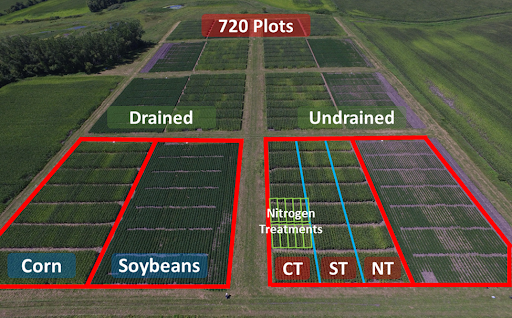
In addition to affecting corn (Zea mays L.) and soybean (Glycine max [L.] Merr.) productivity, soil drainage and tillage practices may also influence the soil nitrogen (N) cycle and the need for N fertilizer application. This seven-year study conducted near Wells, MN investigated the influence of drainage condition (drained and undrained), tillage practice (conventional tillage [CT], strip-tillage [ST], and no-tillage [NT]), and N management (varying N rates and application timings) on corn and soybean grain yield, corn optimal N fertilizer rates (ONR), and residual soil N content. Overall, grain yield in drained compared with undrained soils was 7.6% greater for corn (12.8 vs. 11.9 Mg ha-1) and 2.2% greater for soybean (4.7 vs. 4.6 Mg grain ha-1). For corn, CT and ST in drained soils consistently produced the greatest grain yield, while NT in undrained soils produced the lowest (1.7 Mg grain ha-1 difference). A similar trend was observed for soybean, but the differences were smaller and less frequent (0.3 Mg grain ha-1 difference). These results highlight that drainage and tillage have a larger influence on corn grain yield than on soybean and emphasize that ST is a possible conservation tillage practice option to NT for both corn and soybean. Drainage condition influenced the ONR more than tillage practice. Overall, relative to undrained, drained soils had 16% lower ONR (160 vs. 193 kg N ha-1) and 3.1% greater grain yield at ONR (13.5 vs. 13.1 Mg ha-1), indicating that a large portion of the grain yield losses observed for corn in undrained soils may be related to N deficiency. Compared to split N applications (pre-plant/V6 stage), a single pre-plant N application lowered the ONR in drained soils (151 vs. 168 kg N ha-1), while the opposite occurred for undrained soils (206 vs. 189 kg N ha-1). There were no differences in residual soil N related to drainage condition or tillage practice. These results indicate a greater N use efficiency in drained soils than in undrained, and that split N applications are a better alternative to a single pre-plant application only for undrained soils. Soybean response to N application was variable and produced inconsistent interactions with drainage condition and tillage practice. Overall, N application increased soybean grain yield by 2.5% (0.12 Mg grain ha-1) and oil content by 1.0% (2 g kg-1), but decreased protein content by 1.8% (7 g kg-1) and profit margin by 2.5% ($44.7 ha-1). Similarly, N application to the previous corn crop had little influence on the soybean grown in rotation. The results from this study substantiate the benefits of artificial drainage for corn and soybean production, the fact that ST is a viable conservation tillage alternative to NT, the need to incorporate drainage condition into corn N management guidelines, and the small utility of N application for soybean production.

Gabriel Dias Paiao
LAAS PhD candidate advised by Dr. Fabián Fernández
